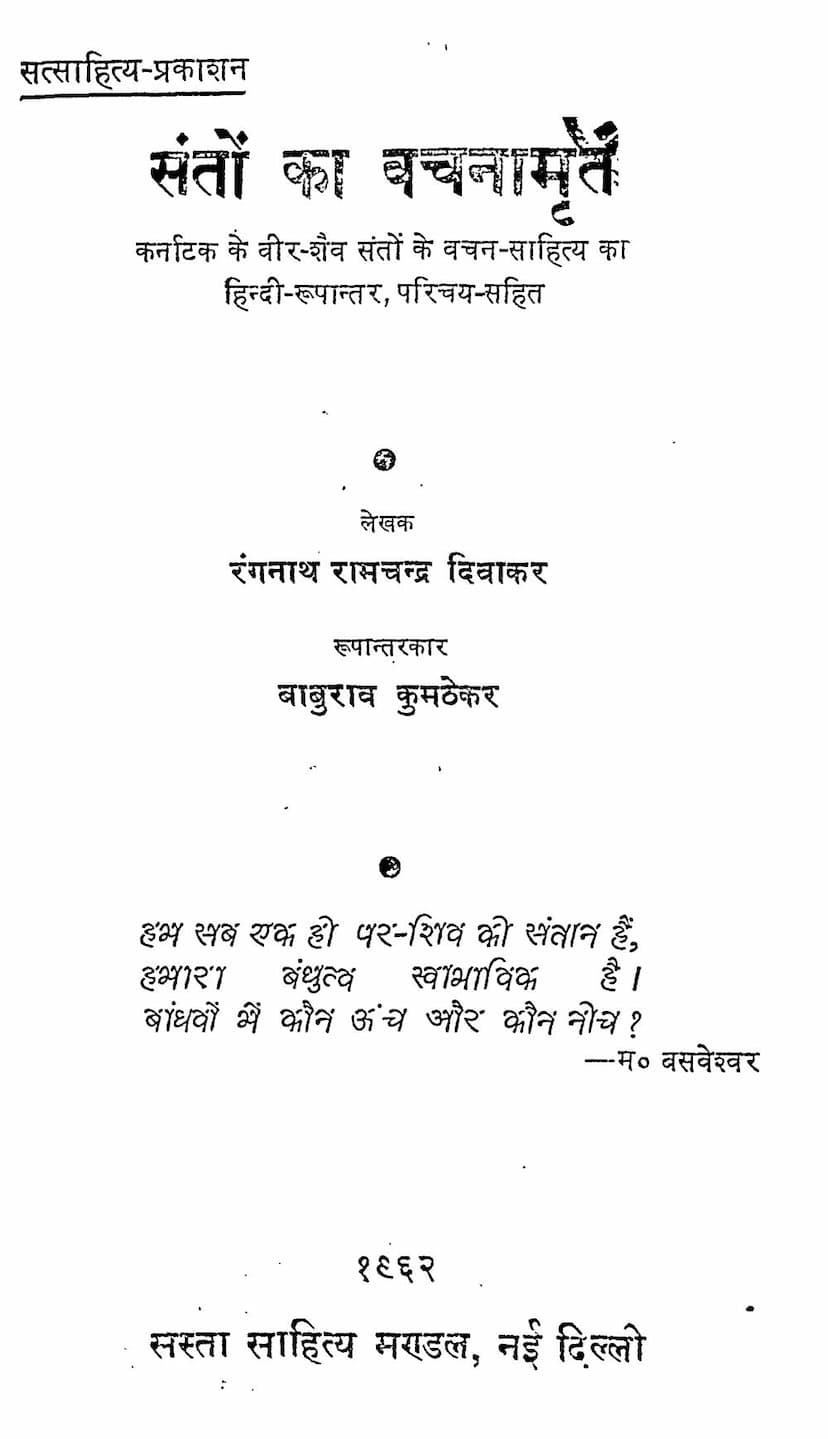Santoka Vachnamrut
Added to library: September 2, 2025

Summary
This is a comprehensive summary of the Jain text "Santoka Vachnamrut" based on the provided pages, focusing on its core themes and message.
Book Title: Santoka Vachnamrut (The Nectar of the Words of Saints) Author: Rangnath Ramchandra Diwakar Translator: Baburao Kumthekar Publisher: Sasta Sahitya Mandal, New Delhi Catalog Link: https://jainqq.org/explore/034103/1
Overall Summary:
"Santoka Vachnamrut" is a Hindi translation of a significant body of devotional literature from the Veerashaiva saints of Karnataka, India. The book aims to introduce Hindi readers to the rich spiritual and philosophical insights contained within the "Vachana Sahitya" (literature of Vachanas). The Vachanas, a unique form of Kannada prose, are the experiences and teachings of Veerashaiva mystics, encompassing a wide range of spiritual, ethical, and philosophical ideas. The book highlights the profound impact of this literature on the folk life of Karnataka and its contribution to Indian culture.
Key Themes and Content:
-
Introduction to Vachana Sahitya: The book begins by introducing Vachana Sahitya as a collection of sayings from numerous Shaiva saints, not a single literary work. It emphasizes the spontaneity and experiential nature of these Vachanas, which are rooted in the saints' direct spiritual realization.
-
The Veerashaiva Saints and their Philosophy:
- Rejection of Dogmatism and Ritualism: The Vachanas strongly advocate for inner realization over external rituals and dogma. They emphasize the importance of personal experience and direct communion with the divine.
- Social Reform: The Veerashaiva saints were pioneers of social reform. They vehemently opposed the caste system, discrimination based on birth, gender, or social status. They promoted the idea of universal brotherhood and equality, seeing all beings as children of the same divine entity (Shiva).
- Emphasis on Action and Ethics: The Vachanas highlight the significance of "Kayakave Kailasa" (Work itself is Kailasa/Heaven), advocating for honest labor and ethical conduct in all aspects of life. They believed that honest work performed with devotion is a form of worship.
- The Ideal of Integrated Life: The saints presented an ideal of life that integrated spiritual pursuit with worldly responsibilities. They were householders, engaged in various professions, yet dedicated to their spiritual path. Their lives demonstrated that spiritual realization is not separate from worldly existence.
- Spiritual Path (Shatsthala): The book details the Veerashaiva concept of "Shatsthala," a six-stage spiritual path (Bhakta, Mahesh, Prasadi, Pranalingi, Sharana, Aikya) leading to ultimate union with the divine. This path is described as a journey of progressive realization and purification.
- The Role of the Guru: The importance of a Guru is emphasized, not just as a ritualistic bestower of initiation, but as a guide who facilitates self-realization and communion with the divine.
-
The Vachanas as "Shastra": The term "Vachana-Shastra" is explained, where "Shastra" refers to a text that guides towards moksha (liberation) and "Vachana" refers to the style of prose in which these teachings are conveyed. It's a guide to achieving eternal bliss and overcoming obstacles in the spiritual journey.
-
Rejection of Idol Worship and Superficiality: The Vachanas criticize blind adherence to rituals, idol worship without inner feeling, and superficial religious practices. They stress the immanence of the divine, stating that the divine is present within oneself and in all creation, not confined to external forms.
-
Equality and Inclusivity: The Vachana movement was remarkably inclusive, welcoming people from all walks of life, castes, and genders. Women also played a significant role as Vachana composers, contributing to the rich tapestry of this literature.
-
Inspiration from Ancient Traditions: While the Vachanas have their unique style and message, their philosophical roots are traced back to the ancient Indian spiritual traditions, including the Upanishads and the Shaivagamas. The text explicitly refutes claims that Veerashaivism was inspired by Islam, highlighting the deep antiquity of its philosophical underpinnings within India.
-
Comparison with Other Traditions: The book also briefly touches upon the similarities and differences in the concept of spiritual realization and devotional practices across various Indian traditions (like Vaishnavism) and even touches upon Western philosophical concepts to provide a broader context.
-
The Nature of the Divine and the Path to Union: The Vachanas describe the divine as formless, attributeless, and beyond human comprehension, yet accessible through devotion, knowledge, and especially through direct spiritual experience (Anubhava). The path advocated is one of surrender, self-surrender, and unwavering faith.
Key Takeaways for the Reader:
- Spiritual Experience Over Ritual: The primary message is that true spirituality lies in inner experience and realization, not mere external observances.
- Social Harmony and Equality: The book promotes a message of social equality, brotherhood, and the rejection of caste-based discrimination.
- Dignity of Labor: Honest work is elevated as a sacred duty and a path to divine communion.
- Holistic Approach to Life: The Vachanas offer a path that integrates spiritual growth with ethical living and social responsibility.
- The Importance of the Guru and Self-Realization: While the Guru is important, the ultimate authority rests on one's own direct spiritual experience.
In essence, "Santoka Vachnamrut" serves as a gateway to a profound spiritual and ethical tradition, showcasing the timeless wisdom of the Veerashaiva saints and their unique literary contribution, the Vachanas, to the world.